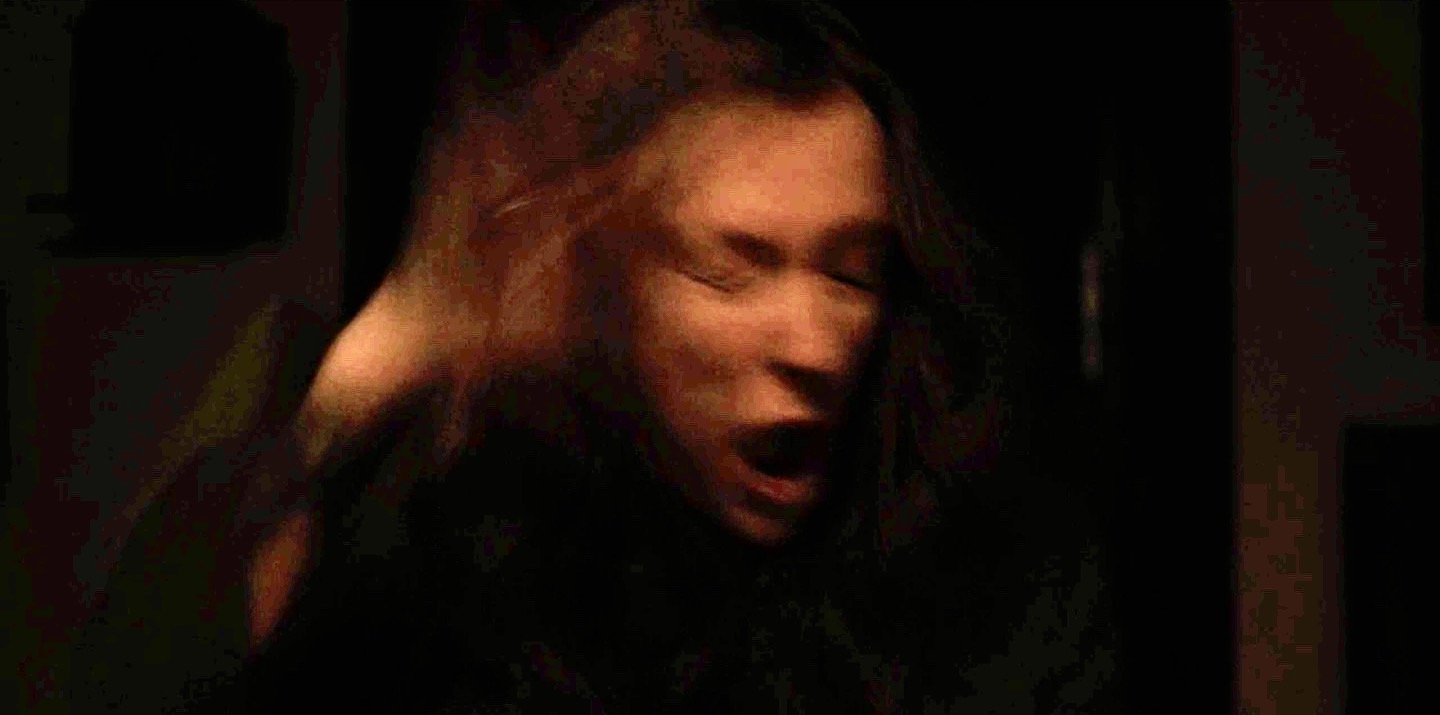The Chilliest Horror in Movies?
The primal shock of sudden movement.
Screen capture from Hereditary (2018), Writer-Director Ari Aster, Cinematographer Pawel Pogorzelski.
When I looked for a screenshot of the nun’s appearance as she first rises into frame at the end of Hitchcock’s Vertigo, I found myself getting nowhere. I couldn’t find a static frame in which this ominous figure begins to be remotely discernible.
I tried later shots, as James Stewart’s Scottie glances over and the film cuts back to the nunnish newcomer, but then she’s already there and simply seeing her without having first succumbed to the shock of her abrupt rise into shot, conjures little horror.
I couldn’t understand. Why, no matter how many times I’d watched this masterpiece, had I experienced the most seismic of shudders, my blood running cold in the instant it took the image I thought I had seen to register?
How come I couldn’t find a single still frame of that jolting moment?
Resigned to failure, I reflected that I had no screen capture to illustrate the article I wanted to write, a piece on under-the-skin chill in horror movies as opposed to the more common visceral or body horror. Yet that single instant in cinema is the most powerful example I can think of what might be described as a subcutaneous jump scare. (A down to earth term for what I used to call a frisson, a word that covers sudden shivers or thrills of other natures too.)
What should I do then, I wondered in my frustration? Find a frame from another film, I thought. I pondered on. De Palma’s Carrie! That’s it! Yes! The hand reaching up from the earth to grab the mourner friend’s arm.
So I try for a screen grab of that. But nothing there barely does justice to the moment either. The movement is so rapid that any individual frame shows little but a peripheral blur. There’s a fundamental difference to the Vertigo shock though — here, as the image moves, we see and we know what we are seeing. While the sudden movement jolts us, we know immediately that this is Carrie’s arm. With Hitchcock’s nun by contrast, we know nothing of who or what we are seeing until the subsequent shot of her.
Master cinematographer Robert Burks lights — or rather darkens — the shot of her appearance for that very effect. Whereas De Palma’s DP Mario Tosi ensures that we register Carrie’s posthumous arm, because that is what the movie needs at this point, Burks shrouds Hitchcock’s mysterious phantasm in impenetrable shadow.
Then, finally, it came to me. I got it! After seeing the Hitchcock vignette more times than I can count — my memory on each occasion subsequently conjuring the image in that split second that was never actually there — I finally found the epiphany of what it is that happens
It’s a movie, stupid! I thought.
The fright I experience is the result of sudden MOVEMENT pure and simple. It’s this abrupt shift alone that scares the living daylights out of me!
And it is NOT seeing clearly what or who it is making this movement that renders the moment so alarming!
What could be more primal — primordial more to the point? What Hitchcock is giving us is the jump scare any creature with eyes to see, or receptors to sense, experiences. The impression, imperfectly sensed, of a sudden change in the environment. Of something else out there! What might it be? A living thing? A mortal threat? A predator?
The most primitive, instant, neural alert that we, like any sentient being, experience.
(With their unremitting, brainless bombast of noise, score, and montage, horror movie trailers completely miss this element, so rarely scare anyone.)
Surely there’s foundation in Hitchcock’s Jesuit education as a boy for a Catholic nun as Scottie’s nemesis. Obsession, desire, erotic longing must be followed by damnation. The inner turmoil of the artist precipitates their greatest art. In Vertigo the master’s greatness, perhaps spurred by his upbringing, is manifested in his articulation of our most fundamental engagement with the world, the abrupt realization of something uncertain and undefined present outside of ourselves.
What shot, then, I wondered, could I use to introduce this article, which would now focus almost exclusively on under-the-skin horror? What, in considering sudden movement, might suffice?
I came up with what you see above, from Ari Aster’s Hereditary — a sudden draft from left of frame and the faint susurrus of it we hear that prompts Annie’s shiver as she’s been looking to Joan, out of shot to frame right. We don’t see that breath, but we do see the abrupt swish of Annie’s hair and the turn of her head as her hand and shoots up.
Unexpected, sudden — a movement literally from out of left field! This, I thought, is the framed jump scare I’ll go with…
As Hitchcock’s nun comments: God have mercy!
Peter Markham July 2023
